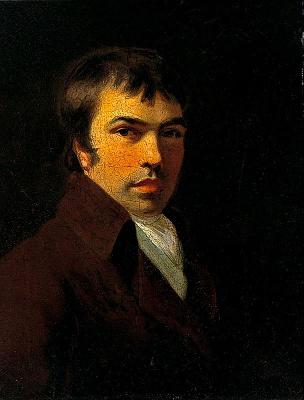John Crome (1768-1821)

'That GAINSBOROUGH, CONSTABLE, and CROME, were men of genius none can dispute,' proclaimed John Wodderspoon on the first page of 'John Crome and his Works' in 1858. While in 1923 Charles Collins Baker, Keeper of the National Gallery, stated that 'Our three greatest masters - Crome, Constable and Turner - demonstrate that landscape painting ... is peculiarly the business of the English genius.'
Yet, one hundred years on, Gainsborough, Turner and Constable are household names, but Crome is not. While Turner started exhibiting at the age of fifteen and Constable around twenty-six, Crome only showed his first works when he was thirty-six.
John Crome lived and worked in Norwich all his life. From humble beginnings he became a drawing master and was one of the principal founders of the Norwich Society of Artists. A careful observer of the natural world, Crome rooted his work in his local surroundings. He provided a snapshot of the Norfolk landscape, focusing on quiet corners, small streams, creaking gates and ancient trees. Crome kept his compositions simple; landscapes were rarely over-populated thus giving an overriding impression of light and air. Views of Norwich regularly feature in his oeuvre, as does the Norfolk coast.
Curator Dr Giorgia Bottinelli introduces the 2021 exhibition:
The Royal Academy's 1878 Winter Exhibition included a section dedicated to the Norwich School. Crome's exhibits at the Academy caught the attention of the American novelist Henry James, who described him as 'a man of genius' and remarked on the historic importance of the Norwich School.
While Crome often looked to the 17th-century Dutch Old Masters, his interpretation was modern and distinctly his own. Crome's handling of the paint was seen as too modern by many reviewers who complained about the sketchy quality and want of finish of his work. Even so, the year Crome died his paintings at the British Institution were praised by at least four national publications. Soon after his death his fame appeared to gain momentum.
Barely two weeks after his funeral the clergyman William Gunn wrote that 'people are now crazy for his pictures which are bought with avidity and sell high' and in a review of the 1824 British Institution, the 'Somerset House Gazette' predicted that 'future connoisseurs' would talk of Constable 'and Gainsborough, and Crome, and Vincent, and Starke [sic] as the Old English Masters.' Although John Crome's reputation has waxed and waned in the following centuries, he remains one of the country's great Romantic painters.
Crome's Norwich
Contemporary photographer Nick Stone walked in the footsteps of John Crome, along river banks and city paths, to revisit the locations which inspired him. Nick has created a self-guided walking tour which takes in some of the locations featured in his work. Read Nick's article 'Finding Crome on the Norwich Castle blog', and follow in Crome's - and Nick's - footsteps to see the places which inspired them both.





